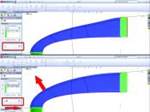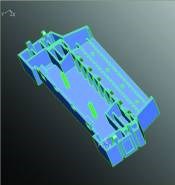What to Look for in CAD Translation Software
Adapting CAD modeling data for CAM is not always a seamless process. Even small inaccuracies in file translation can result in time-consuming manual repairs. And even if the translated data is accurate, some designs may fail to meet manufacturing requirements, increasing the difficulties of cutting the mold or resulting in bad mold configurations that build in extra cycle time, loss of part strength or failure to meet tolerances.
Many moldmakers use third-party translation tools to export CAD data for manufacturing. On the CAD side, such translation software often is feature-based, assessing not just model geometry but the recipe of design features that make up the model, reducing translation errors.
On the moldmaking side, the software embodies expertise that can speed up the process of simplifying CAD data for CAM, verifying and repairing any modeling defects and confirming the manufacturability of the product design.
Moldmakers who are considering adding translation tools to their process should look for the following capabilities:
Simplification
- Does the software identify curves with radii too small for cutting machines to follow?
- Can it simplify surfaces, including those with patches, inconsistencies, and other irregularities, so that the surfaces will promote smooth, chatter-free machine toolpaths?
- Can it confirm that all edges have two contiguous faces so that the model surface is continuous and not leaky?
Verification and Repair
- Can the translation tool identify and repair gaps in the surfaces—often nearly invisible—that will interfere with the creation of toolpaths?
- Does it find and correct slivers and self-intersecting loops created in translation from the original CAD system?
Manufacturability
- Can the software detect problematic product features, such as sharp edges, faces that lack a draft angle and thin walls that reduce part strength?
- Can it assess mold formability and look for convex corners that lack a draft angle to accommodate a cutting tool, deep trenches that may undercut mold strength, and small bumps and features that will build in extra tooling costs?
- Can it warn you of features that will interfere with mold construction, such as undercuts or bosses that will be difficult to fill or will increase cycle time?
Translation software with these capabilities will greatly reduce manual repair, increase manufacturing data quality, and promote mold formability and product manufacturability.
Related Content
-
Mold Builder Uses Counter-Intuitive Approach for Mold Challenges
Matrix Tool Inc. answers customers’ hard questions with creative solutions for cavity spacing, tool sizing, runner layout and melt delivery that reveal the benefits of running in a smaller press size at lower cavitation but higher yield.
-
Predictive Manufacturing Moves Mold Builder into Advanced Medical Component Manufacturing
From a hot rod hobby, medical molds and shop performance to technology extremes, key relationships and a growth strategy, it’s obvious details matter at Eden Tool.
-
The Role of Social Media in Manufacturing
Charles Daniels CFO of Wepco Plastics shares insights on the role of social media in manufacturing, how to improve the “business” side of a small mold shop and continually developing culture.














